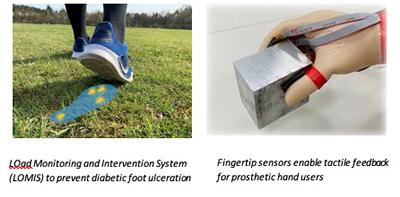Brief description
We take an interdisciplinary user-centred design approach to discover and develop novel body interface sensors, computational modelling, imaging, technologies to help improve the quality of live for people with disabilities and mobility disorders.


Explore this case study
The challenge
The body-device interface plays an important role for both upper and lower limb amputees who wear a prosthesis. Lower limb amputees experience extensive and prolonged forces applied on their residual limbs whilst walking, which can lead to significant discomfort and pain.
People with diabetes can be at significant risk of developing foot ulcers which can lead to amputations. This is a huge problem as many existing risk mitigation approaches lack effectiveness. The problem is caused by loss of foot sensation and changes in foot loading during gait. Currently, there is a lack of suitable sensing solutions to measure real-time pressure (compression) and shear (rubbing) force underneath feet which hinders the development of effective technologies for prevention of foot ulcers in daily living environment. It is both the pressure and shear forces applied over prolonged periods of time that cause tissue breakdown which could quickly develop into ulcers.
We collaborate with some of the best researchers, world leading industry, clinicians and PPI groups to address these unmet needs.
What we do
We are developing a unique tri-axial pressure and shear sensor technology designed for body interface applications. This is a first of its kind platform sensor technology which is safe to wear and functioned to provide real time multidirectional forces at a range of loaded body interfaces. Preliminary studies with limb amputees and people with diabetes have been very successful.
We apply our research to a wide range of biomedical application areas whereby body/device interface loading is critical, such as diabetic insoles, mattresses, special seating, assistive rehabilitation robotics, and feedback systems for chest compression in reviving cardiac arrest.
We also conduct novel musculoskeletal research using computational means and biomechanical analysis to generate new understanding in the interdisciplinary fields of engineering and physics, clinical rehabilitation and assistive technology.
Our research and innovation is supported by an extensive collaboration network and a broad funding portfolio.
Our impact
- Extensive media coverage including interviews by BBC news, ITV, British Force TV, and many live national radio stations, newspapers, and science magazines
- Publications including an Editor’s Choice paper for Medical Engineering and Physics, also a cover page paper for Prosthetics and Orthotics International
- Our research in prosthetics and orthotics has won prestigious national and international prizes including the Limbless Association Prize 2014, Best Free Paper BLESMA Prize 2015, IET William James Prize 2015, Best Paper Prize for Advancing Technology at ISPO World Congress 2017, IMechE 2019 healthcare technologies early career award
- The University of Southampton is one of the four universities leading the current EPSRC Centre for Doctoral Training in Prosthetics and Orthotics, with Professor Liudi Jiang serving as the Engineering Lead
- Further research is currently underway to translate our breath of research and innovation to clinically applicable tools, effectively assisting patient care and rehabilitation
The facilities we used and partners we work with
Our work is primarily based in our state-of-the-art Healthcare Technology Laboratory
We also work with :


